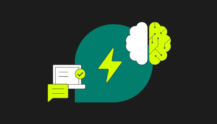Author: Heidi Williams
Last year, the promising productivity trend line that took hold in 2020 took a dramatic nosedive. Employees who had produced at record levels at the onset of remote work hit a metaphorical wall, and many completely burned out.
Although hybrid work has benefits, it isn’t without challenges to meaningful connection, which can lead to isolation, weakened relationships, and a lack of trust. Leaders can turn to a new wave of AI technology to augment their teams’ emotional intelligence—empowering authentic connections that recharge employee productivity.
Emotional intelligence is no longer a soft skill in hybrid workplaces
New research from IDC, sponsored by Grammarly, explores how leading enterprises are investing in technology to enhance employee communication skills. According to Marci Maddox, IDC’s research VP of digital experience strategies, 75% of organizations have adopted very or extremely flexible work policies. In today’s hybrid environments, where work with colleagues often takes place through videoconferencing calls or over instant messaging applications, communication is the lever for building trusting relationships. And relationships matter: A recent Grammarly poll found that close to a third (29.9%) of professionals say that a lack of personal connections at work impacts their job effectiveness. In other words, feelings of isolation lead to lower productivity.
Strong communicators hold the key to building successful workplace relationships. The most effective communicators exhibit professionalism, reliability, accuracy, and persuasiveness, but ticking all those boxes can be challenging when communication takes place on a variety of channels and often without physical cues such as body language to aid the delivery of a message.
Synchronous work (i.e., work that happens in real time, such as in a video meeting) gives collaborators the opportunity to clarify ideas, gauge reactions, and even read physical cues. Coworkers can adjust on the fly to move toward shared understanding. With asynchronous work (i.e., work that doesn’t take place in real time, such as email or text-based chat), it can be more difficult to communicate ideas clearly and to distinguish subtleties such as tone. As a result, trust among team members can erode, and employees can feel increasingly isolated.
Getting the message right requires that the sender deliver it with clarity, empathy, and the right tone—in other words, it takes greater emotional intelligence. The ability to communicate ideas with emotional context is therefore no longer a soft skill. In a hybrid world, emotional intelligence is a must-have skill set to effectively collaborate with coworkers and drive productivity.
Enterprises are rethinking employee engagement and productivity with new AI tools
Some early efforts to improve emotional intelligence and connections in the workplace via AI have proven controversial. Often, they’ve focused too much on monitoring emotional states rather than giving teams tools to collaborate more meaningfully. We’ll see the tide turn to AI that empowers teams to build emotional intelligence, helping them with aspects such as using the right tone and level of empathy for a given situation so they can strengthen relationships.
A new wave of AI and augmentative technologies, which IDC calls “real-time communication assistance,” offers this type of support. Real-time communication assistance technology provides users with real-time feedback to help them improve the delivery of their message. For example, Grammarly Business provides in-line suggestions to help individuals enhance the clarity and tone of their message for more positive workplace interactions. In the aforementioned research, IDC found that organizations that leverage this type of technology see several benefits, including improved tone and formality of writing (37%), improved worker productivity (37%), and improved writing quality (33%).
It’s time to strengthen workplace communication and relationships
For so long, emotional intelligence was considered a soft skill with an unclear impact on the bottom line. Now, and for the foreseeable future, it’s a competitive differentiator for forging strong cross-functional relationships that in turn support a more productive and efficient workforce.
Leaders must remember to bring communication quality—and tools that aid it—into the discussion when planning productivity improvements in 2023. Even with high emotional intelligence, workplace communication can be difficult if writing is unclear. Misunderstandings lead to unnecessary rework, mistakes, team friction, and isolation.
AI communication assistance bridges the gap between the intention of a sender and the perception of a recipient to enhance communication effectiveness at every level of the organization, empowering employees to collaborate more meaningfully, build trust, and achieve better outcomes.
For more information on how enterprises are using communication to tackle the challenges of the modern workplace, read IDC’s full research, sponsored by Grammarly.
IDC InfoBrief, sponsored by Grammarly, Workplace Experiences of the Digital-First Enterprise, IDC Doc. #US49892622, December 2022




